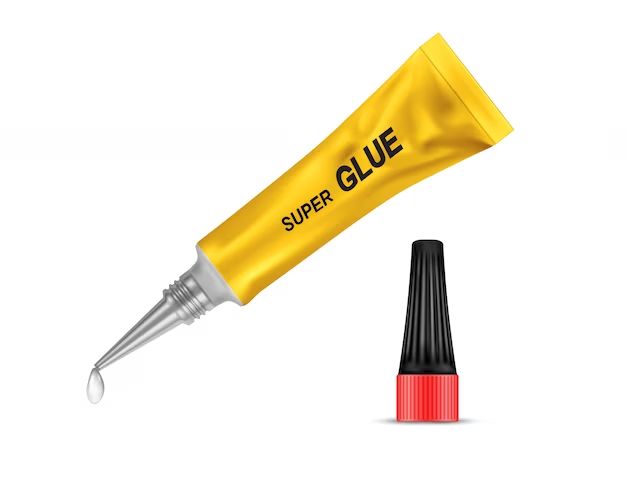Super glue and rubber cement are both popular household adhesives, but they have some key differences that make them suitable for different applications. Knowing when to use one over the other can ensure your arts and crafts projects turn out their best.
Page Contents
What is Super Glue?
Super glue, also known as cyanoacrylate glue, is a fast-drying adhesive that bonds almost instantly on contact. The glue cures through a chemical reaction when it comes in contact with moisture on the surfaces being bonded.
Super glue is available in both liquid and gel forms. The liquid glue offers extremely fast bonding and wicking action to fill gaps between materials. The gel formula has a thicker consistency that helps prevent runoff on vertical surfaces and gives you more time to align pieces before the bond sets.
Here are some key features and uses of super glue:
- Bonds extremely fast, often in less than a minute
- Creates very strong, rigid bonds with plastics, metals, rubber, and more
- Useful for bonding smooth, close-fitting surfaces
- Fills small gaps between materials
- Commonly used for minor repairs around the home, crafts, and hobbies
What is Rubber Cement?
Rubber cement is a latex-based adhesive that contains rubber particles suspended in a volatile solvent. It is commonly used in arts and crafts applications like collages and scrapbooking where a temporary, repositionable bond is desired.
Here are some key features of rubber cement:
- Creates a relatively weak, flexible bond between porous materials
- Allows repositioning of items while the cement is still wet
- Dries fast but remains repositionable for a short time after drying
- Easy cleanup with water while still wet
- Good choice for materials like paper, cardboard, fabric, and wood
- Not suitable for non-porous surfaces like plastic and metal
Key Differences Between Super Glue and Rubber Cement
While both products are liquid adhesives commonly used around the home, super glue and rubber cement have very different properties and uses:
| Property | Super Glue | Rubber Cement |
|---|---|---|
| Bond strength | Extremely strong | Relatively weak |
| Flexibility | Brittle, rigid bond | Flexible bond |
| Cure time | Sets in seconds | Several minutes |
| Repositioning | Not possible once bonded | Possible while wet |
| Materials | Plastics, metals, rubber, more | Porous materials like paper, wood, fabric |
| Cleanup | With acetone or nail polish remover | With water and soap while wet |
As you can see, the main differences come down to bond strength, flexibility, repositionability, suitable materials, and cleanup methods.
Can You Use Super Glue Instead of Rubber Cement?
Using super glue instead of rubber cement is not recommended in most cases. Here are some key reasons why:
- Super glue forms a rigid, permanent bond that makes repositioning impossible.
- The fast cure time doesn’t allow time to realign bonded pieces.
- It may soak into porous surfaces and leave ugly stained edges.
- There is a higher risk of ruining a project with super glue mistakes.
- It does not work well on porous, non-smooth surfaces like paper or wood.
The inflexible, permanent bond of super glue goes against the main benefit of rubber cement – the ability to reposition bonded items while the adhesive is still pliable. Using super glue could make craft projects and artistic collages frustrating or impossible to assemble neatly and accurately.
However, there are a few situations where super glue may provide a better solution than rubber cement:
- If you need an extremely strong, permanent bond for hard materials like metal, plastic, or ceramic.
- When working with non-porous materials where rubber cement won’t adhere effectively.
- For microscopic repairs or precision bonding of tiny pieces.
- If you need to fill small gaps between close-fitting surfaces.
Overall though, opt for quality rubber cement if you are doing paper crafts, decoupage, scrapbooking, making posters, and most other porous material projects that require flexibility, repositioning, and an easy cleanup. The removable bond is ideal for situations where mistakes can happen and changes may be needed.
Tips for Using Rubber Cement Effectively
Follow these tips to get the best results when using rubber cement:
- Apply cement sparingly to one surface using the applicator brush. Too much can cause wrinkling.
- Let it dry for 1-2 minutes until no longer transfers to the touch.
- Align surfaces and press down firmly to transfer cement.
- Slide pieces around to adjust alignment before cement sets, within 5-10 minutes typically.
- Use wax paper between layers to avoid sticking until fully assembled.
- Allow several hours for full bond strength to develop.
- To separate, gently peel surfaces apart while slowly pulling parallel to bond line.
Proper use will give you a strong yet maneuverable bond. Remember to use rubber cement in well-ventilated areas and avoid inhaling fumes. With some practice, you’ll find it is an ideal adhesive for crafts and art projects allowing mistakes to be fixed during assembly.
Conclusion
In summary, super glue forms rigid bonds too quickly and permanantly to be an effective substitute for rubber cement in most paper crafts, collage work, scrapbooking, and similar applications. The flexibility and repositionability of rubber cement gives you more control over the assembly process without ruining pieces that bond incorrectly. Super glue is better reserved for precise bonding of hard materials where its instant grab and fill properties can be utilized. Be sure to choose the adhesive that best matches your particular project needs.
